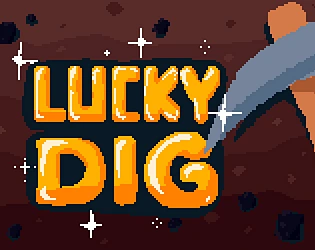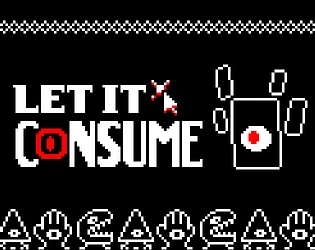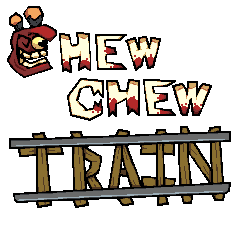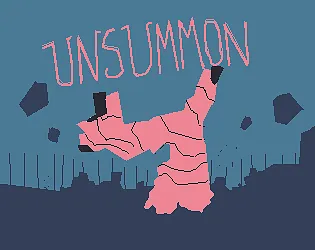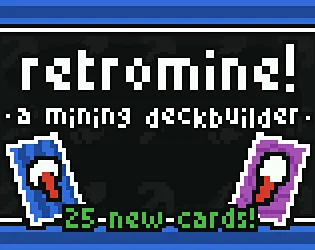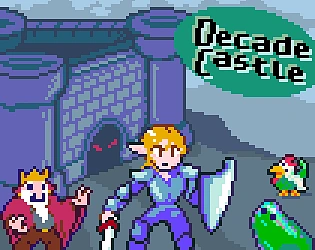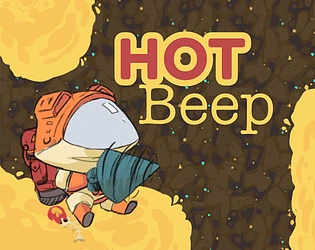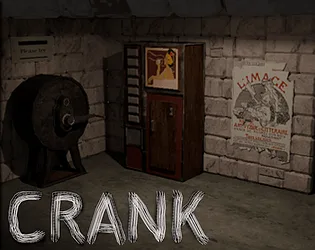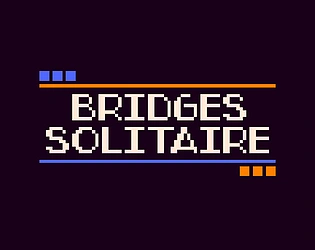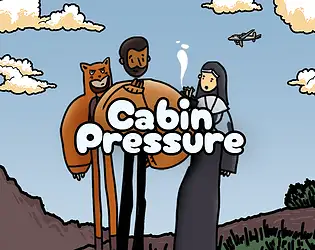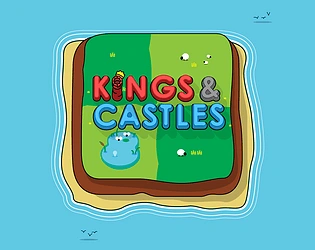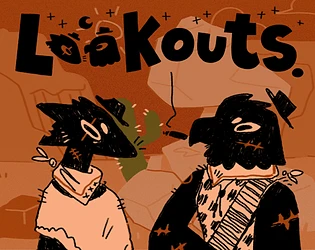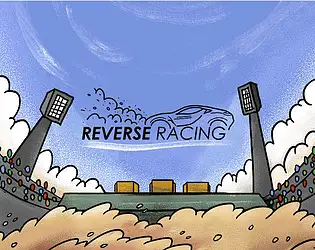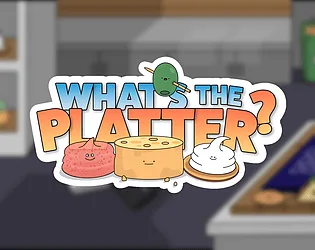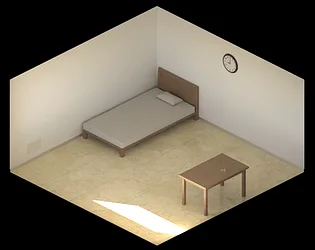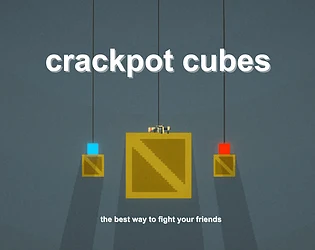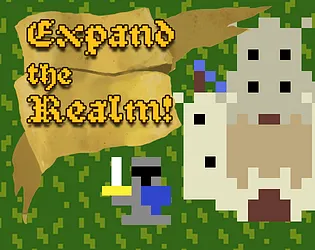
Expand the Realm
Build farms, mines, and castles in this minimalist hexagonal strategy game
Expand the Realm
Expand the Realm — Minimal Choices, Maximum Strategy

Expand the Realm explores a fascinating game design question: What is the minimum player agency that still makes a game? The answer is three building types. You can build farms, mines, or castles—nothing more. Yet from this extreme simplicity emerges a surprisingly deep strategic puzzle about resource management, trade route optimization, and organic kingdom growth.
🎮 What is Expand the Realm?
Expand the Realm is a minimalist strategy game built on hexagonal grids that change with every playthrough. Your goal is straightforward: expand your kingdom until it covers 50% of the available space. How you achieve this with just three building options creates the entire strategic depth.
Here's how the economy works:
- Farms produce food—the foundation of your civilization
- Mines produce iron—necessary for military operations
- Castles create knights who protect your people, but require iron to operate
Every building requires food to function. Run out of food, and your people riot. It's a delicate balance: produce enough food to sustain growth, mine enough iron to power your castles, and build enough castles to protect expanding settlements.
But there's a brilliant twist: trade routes. Every new settlement you construct creates a route back to your capital city. The longer this route—the more stops along the way—the more gold it generates. Settlements along prosperous routes accumulate wealth, and when a settlement reaches sufficient prosperity, it automatically generates a residence: an additional building placed adjacent to it.
This creates emergent gameplay. You're not just placing buildings based on immediate needs—you're thinking about trade route length, settlement positioning, and the inadvertent population growth that comes from prosperity. Sometimes the optimal move isn't the obvious one.
The game uses wavefunction collapse for procedural world generation, ensuring every hexagonal map is unique. Each playthrough presents different terrain configurations, forcing you to adapt your strategy.
🕹️ How to Play Expand the Realm
Expand the Realm features intuitive controls focused on strategic building placement:
Controls
| Action | Input |
|---|---|
| Select Building Type | Click building icon (Farm/Mine/Castle) |
| Place Building | Click hexagonal tile on map |
| Open Menu | ESC |
| Access Tutorial | ESC → "How To Play" |
| Pan Map | Click and drag |
| Zoom | Mouse wheel (if available) |
Game Mechanics
Building Types:
| Building | Produces | Requires | Purpose |
|---|---|---|---|
| Farm | Food | - | Sustains all buildings and prevents riots |
| Mine | Iron | Food | Provides materials for castle operation |
| Castle | Knights | Food + Iron | Protects settlements and people |
Core Systems:
- Resource Balance – Every building needs food; castles also need iron
- Trade Routes – Each settlement connects to the capital, generating gold
- Prosperity – Longer trade routes = more wealth = automatic residence generation
- Organic Growth – Successful settlements spawn additional buildings without your input
- Territory Expansion – Goal is to cover 50% of the map with your realm
Strategy Tips
- Start with farms – Food is the universal requirement; secure it first
- Plan trade routes – Longer routes generate more gold and prosperity
- Balance iron production – Too many castles without mines will fail
- Think about connections – Settlement placement affects route efficiency
- Let prosperity work – Sometimes the best move is waiting for automatic residence generation
- Don't overexpand – Spreading too fast without food production causes riots
📸 Expand the Realm Gameplay Walkthrough
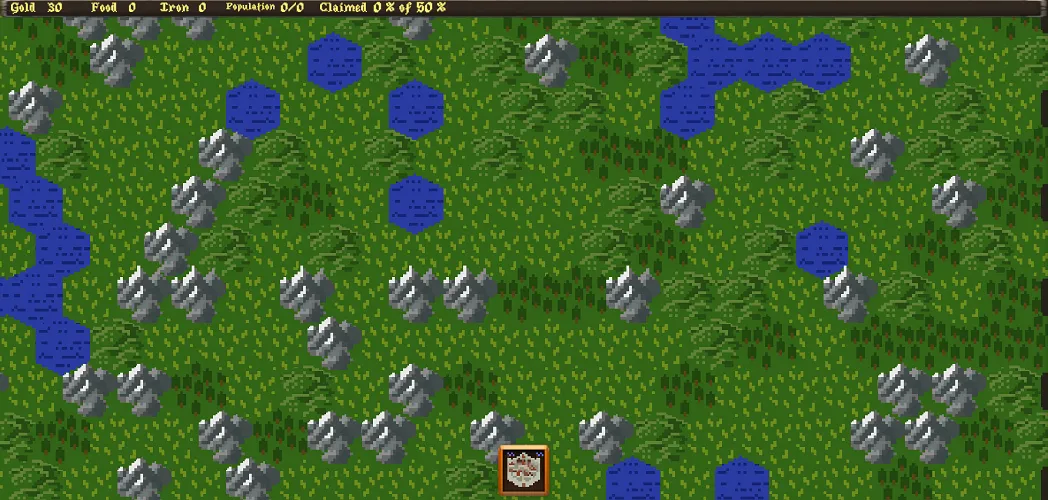
🏰 Establishing Your Capital
Every game of Expand the Realm begins with your capital city positioned on a procedurally generated hexagonal world map. The terrain varies each time—different land configurations, different strategic opportunities, different challenges.
Your first decisions are critical. With only three building types available, you need to prioritize carefully. Most players start by building farms near the capital to establish food production. Without food, every building fails, making farms the foundation of any successful realm.
But you also need to think ahead. Where will you build your first mine? Where should your first castle go? The hexagonal grid constrains your options—each building takes up space, and positioning matters for future trade routes.
The tutorial (accessible via ESC → "How To Play") explains these fundamentals clearly, teaching you the relationship between buildings, resources, and growth. It's worth reading even if you're familiar with strategy games, as Expand the Realm has unique mechanics.
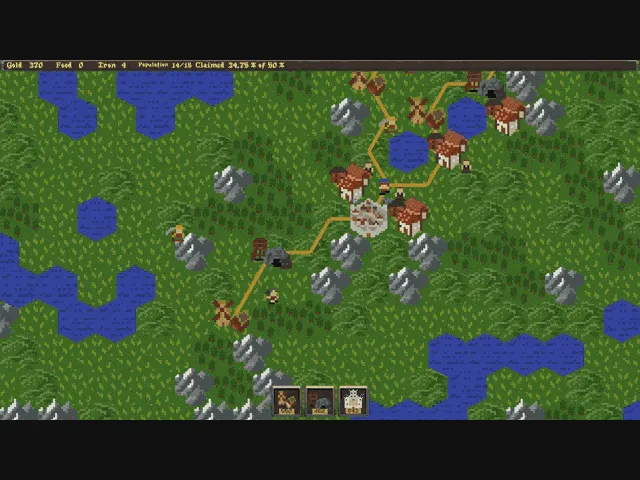
🌾 Balancing Resources
Once you've established basic food production, Expand the Realm becomes an optimization puzzle. You're constantly balancing three resources:
Food – The universal need. Every farm, mine, and castle requires food. Run out, and your people riot, collapsing your carefully constructed economy.
Iron – Needed exclusively for castles. Too many castles without sufficient mines, and they shut down. Too many mines without enough farms to support them, and you can't produce the iron you need.
Gold – Generated automatically by trade routes. You don't directly control gold production, but you influence it through settlement placement and route length.
The brilliance of this system is how interconnected everything becomes. You can't just spam farms—you need castles for protection and mines for iron. But you can't build castles without iron, and you can't sustain mines without food. Every placement decision creates ripple effects.
This is where the game's minimalism shines. With only three options, you can't hide mistakes in complexity. Strategic clarity is both the challenge and the reward.
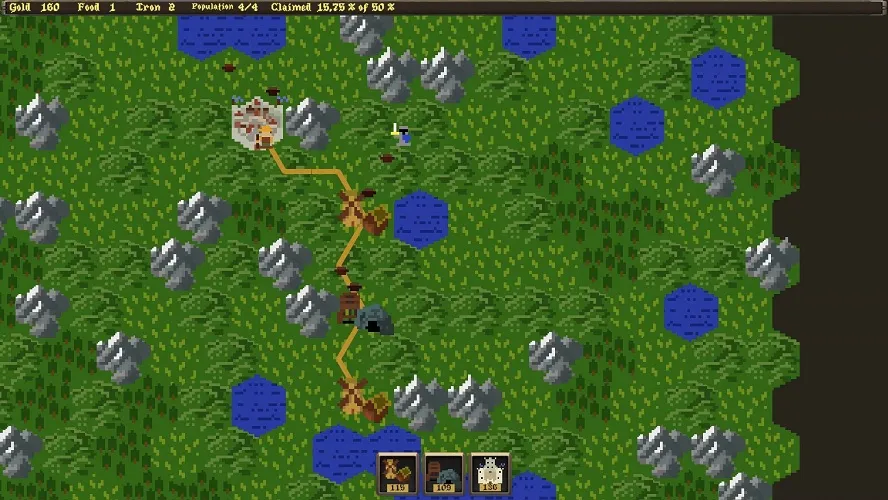
🛤️ Optimizing Trade Routes
The trade route system is where Expand the Realm reveals its depth. Every settlement you build creates a route back to the capital. The route's length—measured in stops along the way—determines how much gold it generates.
Here's the strategic insight: longer routes can be more valuable than shorter ones. If you build a settlement far from the capital with several existing settlements in between, that new settlement's route passes through all those intermediate stops. Gold accumulates at every point along the route.
This creates fascinating decisions. Should you expand close to existing settlements for safety and efficiency? Or push outward to create longer, more profitable routes? The answer depends on your current resource balance, territory coverage, and proximity to the 50% expansion goal.
Prosperous settlements—those accumulating enough wealth from trade routes—automatically generate residences. These additional buildings appear adjacent to successful settlements without requiring your input. It's organic growth rewarding good strategic planning.
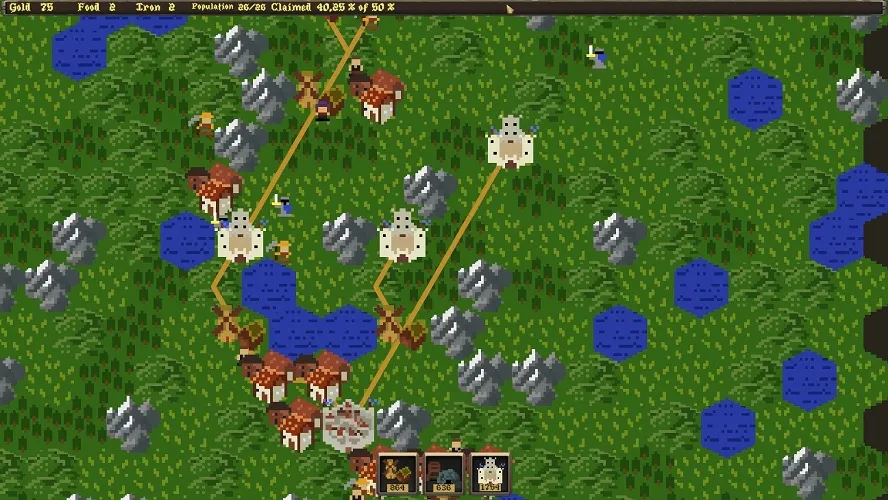
🏆 Achieving 50% Expansion
The goal in Expand the Realm is clear: cover 50% of the available map with your kingdom. As you approach this threshold, strategic pressures intensify.
You need to maintain resource balance while pushing expansion. Every new settlement requires food, potentially straining your farms. Distant settlements create long trade routes but are harder to support logistically. The hexagonal grid's finite space means you're constantly making spatial efficiency decisions.
Late-game strategy often involves:
- Calculated expansion – Building settlements that maximize route value while staying resource-positive
- Prosperity farming – Creating conditions for automatic residence generation to fill gaps
- Defensive placement – Ensuring castles protect vulnerable settlements
- Food surplus management – Maintaining enough farms to support final expansion pushes
When you finally cross the 50% threshold, you've proven you can manage complexity through minimalism. You've turned three building types into a thriving kingdom, balanced competing resource needs, optimized trade networks, and guided organic growth.
Expand the Realm demonstrates that strategic depth doesn't require overwhelming options. Sometimes, limiting player agency forces more creative, thoughtful decision-making. With just farms, mines, and castles, you can build an empire—or watch it collapse through poor resource management. The choice is yours, but the choices are wonderfully simple.
Expand the Realm — Minimal Choices, Maximum Strategy

Expand the Realm explores a fascinating game design question: What is the minimum player agency that still makes a game? The answer is three building types. You can build farms, mines, or castles—nothing more. Yet from this extreme simplicity emerges a surprisingly deep strategic puzzle about resource management, trade route optimization, and organic kingdom growth.
🎮 What is Expand the Realm?
Expand the Realm is a minimalist strategy game built on hexagonal grids that change with every playthrough. Your goal is straightforward: expand your kingdom until it covers 50% of the available space. How you achieve this with just three building options creates the entire strategic depth.
Here's how the economy works:
- Farms produce food—the foundation of your civilization
- Mines produce iron—necessary for military operations
- Castles create knights who protect your people, but require iron to operate
Every building requires food to function. Run out of food, and your people riot. It's a delicate balance: produce enough food to sustain growth, mine enough iron to power your castles, and build enough castles to protect expanding settlements.
But there's a brilliant twist: trade routes. Every new settlement you construct creates a route back to your capital city. The longer this route—the more stops along the way—the more gold it generates. Settlements along prosperous routes accumulate wealth, and when a settlement reaches sufficient prosperity, it automatically generates a residence: an additional building placed adjacent to it.
This creates emergent gameplay. You're not just placing buildings based on immediate needs—you're thinking about trade route length, settlement positioning, and the inadvertent population growth that comes from prosperity. Sometimes the optimal move isn't the obvious one.
The game uses wavefunction collapse for procedural world generation, ensuring every hexagonal map is unique. Each playthrough presents different terrain configurations, forcing you to adapt your strategy.
🕹️ How to Play Expand the Realm
Expand the Realm features intuitive controls focused on strategic building placement:
Controls
| Action | Input |
|---|---|
| Select Building Type | Click building icon (Farm/Mine/Castle) |
| Place Building | Click hexagonal tile on map |
| Open Menu | ESC |
| Access Tutorial | ESC → "How To Play" |
| Pan Map | Click and drag |
| Zoom | Mouse wheel (if available) |
Game Mechanics
Building Types:
| Building | Produces | Requires | Purpose |
|---|---|---|---|
| Farm | Food | - | Sustains all buildings and prevents riots |
| Mine | Iron | Food | Provides materials for castle operation |
| Castle | Knights | Food + Iron | Protects settlements and people |
Core Systems:
- Resource Balance – Every building needs food; castles also need iron
- Trade Routes – Each settlement connects to the capital, generating gold
- Prosperity – Longer trade routes = more wealth = automatic residence generation
- Organic Growth – Successful settlements spawn additional buildings without your input
- Territory Expansion – Goal is to cover 50% of the map with your realm
Strategy Tips
- Start with farms – Food is the universal requirement; secure it first
- Plan trade routes – Longer routes generate more gold and prosperity
- Balance iron production – Too many castles without mines will fail
- Think about connections – Settlement placement affects route efficiency
- Let prosperity work – Sometimes the best move is waiting for automatic residence generation
- Don't overexpand – Spreading too fast without food production causes riots
📸 Expand the Realm Gameplay Walkthrough

🏰 Establishing Your Capital
Every game of Expand the Realm begins with your capital city positioned on a procedurally generated hexagonal world map. The terrain varies each time—different land configurations, different strategic opportunities, different challenges.
Your first decisions are critical. With only three building types available, you need to prioritize carefully. Most players start by building farms near the capital to establish food production. Without food, every building fails, making farms the foundation of any successful realm.
But you also need to think ahead. Where will you build your first mine? Where should your first castle go? The hexagonal grid constrains your options—each building takes up space, and positioning matters for future trade routes.
The tutorial (accessible via ESC → "How To Play") explains these fundamentals clearly, teaching you the relationship between buildings, resources, and growth. It's worth reading even if you're familiar with strategy games, as Expand the Realm has unique mechanics.

🌾 Balancing Resources
Once you've established basic food production, Expand the Realm becomes an optimization puzzle. You're constantly balancing three resources:
Food – The universal need. Every farm, mine, and castle requires food. Run out, and your people riot, collapsing your carefully constructed economy.
Iron – Needed exclusively for castles. Too many castles without sufficient mines, and they shut down. Too many mines without enough farms to support them, and you can't produce the iron you need.
Gold – Generated automatically by trade routes. You don't directly control gold production, but you influence it through settlement placement and route length.
The brilliance of this system is how interconnected everything becomes. You can't just spam farms—you need castles for protection and mines for iron. But you can't build castles without iron, and you can't sustain mines without food. Every placement decision creates ripple effects.
This is where the game's minimalism shines. With only three options, you can't hide mistakes in complexity. Strategic clarity is both the challenge and the reward.

🛤️ Optimizing Trade Routes
The trade route system is where Expand the Realm reveals its depth. Every settlement you build creates a route back to the capital. The route's length—measured in stops along the way—determines how much gold it generates.
Here's the strategic insight: longer routes can be more valuable than shorter ones. If you build a settlement far from the capital with several existing settlements in between, that new settlement's route passes through all those intermediate stops. Gold accumulates at every point along the route.
This creates fascinating decisions. Should you expand close to existing settlements for safety and efficiency? Or push outward to create longer, more profitable routes? The answer depends on your current resource balance, territory coverage, and proximity to the 50% expansion goal.
Prosperous settlements—those accumulating enough wealth from trade routes—automatically generate residences. These additional buildings appear adjacent to successful settlements without requiring your input. It's organic growth rewarding good strategic planning.

🏆 Achieving 50% Expansion
The goal in Expand the Realm is clear: cover 50% of the available map with your kingdom. As you approach this threshold, strategic pressures intensify.
You need to maintain resource balance while pushing expansion. Every new settlement requires food, potentially straining your farms. Distant settlements create long trade routes but are harder to support logistically. The hexagonal grid's finite space means you're constantly making spatial efficiency decisions.
Late-game strategy often involves:
- Calculated expansion – Building settlements that maximize route value while staying resource-positive
- Prosperity farming – Creating conditions for automatic residence generation to fill gaps
- Defensive placement – Ensuring castles protect vulnerable settlements
- Food surplus management – Maintaining enough farms to support final expansion pushes
When you finally cross the 50% threshold, you've proven you can manage complexity through minimalism. You've turned three building types into a thriving kingdom, balanced competing resource needs, optimized trade networks, and guided organic growth.
Expand the Realm demonstrates that strategic depth doesn't require overwhelming options. Sometimes, limiting player agency forces more creative, thoughtful decision-making. With just farms, mines, and castles, you can build an empire—or watch it collapse through poor resource management. The choice is yours, but the choices are wonderfully simple.
Release date
Developer
Platform
